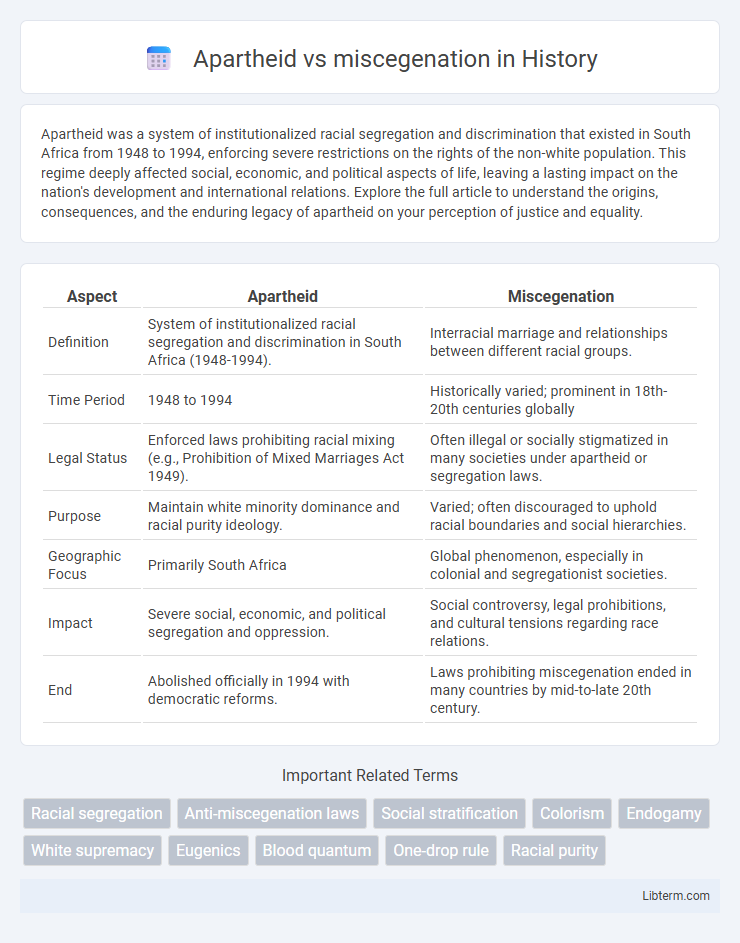Apartheid was a system of institutionalized racial segregation and discrimination that existed in South Africa from 1948 to 1994, enforcing severe restrictions on the rights of the non-white population. This regime deeply affected social, economic, and political aspects of life, leaving a lasting impact on the nation's development and international relations. Explore the full article to understand the origins, consequences, and the enduring legacy of apartheid on your perception of justice and equality.
Table of Comparison
| Aspect | Apartheid | Miscegenation |
|---|---|---|
| Definition | System of institutionalized racial segregation and discrimination in South Africa (1948-1994). | Interracial marriage and relationships between different racial groups. |
| Time Period | 1948 to 1994 | Historically varied; prominent in 18th-20th centuries globally |
| Legal Status | Enforced laws prohibiting racial mixing (e.g., Prohibition of Mixed Marriages Act 1949). | Often illegal or socially stigmatized in many societies under apartheid or segregation laws. |
| Purpose | Maintain white minority dominance and racial purity ideology. | Varied; often discouraged to uphold racial boundaries and social hierarchies. |
| Geographic Focus | Primarily South Africa | Global phenomenon, especially in colonial and segregationist societies. |
| Impact | Severe social, economic, and political segregation and oppression. | Social controversy, legal prohibitions, and cultural tensions regarding race relations. |
| End | Abolished officially in 1994 with democratic reforms. | Laws prohibiting miscegenation ended in many countries by mid-to-late 20th century. |
Defining Apartheid: Origins and Principles
Apartheid, a systematic policy of racial segregation, originated in South Africa in 1948 and was designed to maintain white minority rule by enforcing strict racial classification and separation. The principles of Apartheid included prohibiting inter-racial marriages and relationships, which directly opposed miscegenation--the mixing of different racial groups. This legal framework sought to control social, economic, and political interactions between races, institutionalizing inequality and oppression.
Understanding Miscegenation: Historical Context
Miscegenation refers to the interbreeding of people considered to be of different racial backgrounds, often targeted by anti-miscegenation laws during the apartheid era in South Africa. These laws aimed to maintain racial segregation by prohibiting interracial marriages and relationships, reinforcing systemic discrimination and social hierarchies. Historical context reveals that apartheid policies institutionalized racial purity, making miscegenation a focal point of legal and social control to preserve white supremacy.
Legal Frameworks: Apartheid Laws vs. Anti-Miscegenation Laws
Apartheid laws in South Africa enforced rigid racial segregation by legally classifying individuals and restricting interactions between racial groups, often prohibiting mixed marriages and relationships under statutes like the Prohibition of Mixed Marriages Act (1949) and the Immorality Act (1950). Similarly, anti-miscegenation laws in the United States, prevalent primarily in Southern states until the mid-20th century, criminalized interracial marriages and cohabitation, upheld until the landmark 1967 Supreme Court case Loving v. Virginia invalidated these statutes nationwide. Both legal frameworks institutionalized racial discrimination, maintaining social hierarchies by legislating personal relationships and reinforcing systemic segregation.
Social Impacts of Apartheid Policies
Apartheid policies institutionalized racial segregation, severely limiting social interaction and marriage between races, which reinforced systemic inequalities and social fragmentation. The prohibition of miscegenation under apartheid law prevented interracial relationships, perpetuating racial hierarchies and social stigmatization. These policies entrenched social divisions, restricted cultural exchange, and contributed to long-term social disparities in education, employment, and community cohesion.
The Consequences of Banning Miscegenation
Banning miscegenation during apartheid reinforced racial segregation by legally prohibiting interracial marriages and relationships, which institutionalized racial hierarchy and social division. This prohibition contributed to the marginalization and criminalization of mixed-race individuals, undermining their civil rights and social acceptance. The long-term consequences included deep-rooted racial tensions and systemic inequalities that persisted even after apartheid's end.
Racial Segregation: Enforcement and Resistance
Apartheid enforced strict racial segregation laws in South Africa, prohibiting miscegenation through legal measures such as the Prohibition of Mixed Marriages Act (1949) and the Immorality Act (1950). These laws aimed to maintain white supremacy by stopping interracial relationships, leading to harsh penalties and social stigmatization. Resistance movements, including the African National Congress and various civil rights activists, challenged these laws through protests, legal battles, and underground campaigns promoting racial equality and integration.
Global Perspectives: Apartheid and Miscegenation Worldwide
Apartheid, institutionalized racial segregation primarily known from South Africa, shares global parallels with miscegenation laws that prohibited interracial marriage and relationships in countries like the United States, Brazil, and Australia. Both systems served to enforce racial hierarchies and social divisions, with apartheid codifying separation in public life and miscegenation laws targeting intimate and familial bonds. Internationally, the dismantling of apartheid and the repeal of miscegenation laws marked significant progress toward racial equality, reflecting a global shift against legislated racial discrimination.
Cultural Narratives and Stereotypes
Apartheid enforced rigid racial segregation and propagated stereotypes portraying non-white groups as inferior, reinforcing a cultural narrative that justified systemic discrimination. Miscegenation challenged these racial boundaries by promoting interracial relationships, which apartheid regimes depicted as threats to social order and racial purity, fueling stigmatization and prejudice. These opposing forces shaped deeply rooted cultural narratives, influencing identity, social interaction, and power dynamics in segregated societies.
Legacies and Enduring Effects
Apartheid's legacy entrenched racial segregation and systemic inequality in South Africa, creating deep socio-economic disparities that persist today, while miscegenation laws, by criminalizing interracial relationships, reinforced racial divisions and stigmatization globally. The abolition of apartheid and anti-miscegenation statutes has led to gradual societal integration, but enduring effects include persistent racial biases and institutional inequalities. Understanding these historical frameworks is crucial for addressing ongoing challenges in racial reconciliation and equality policies.
Moving Forward: Reconciliation and Social Integration
Efforts for moving forward from apartheid emphasize reconciliation and social integration through truth commissions, reparations, and inclusive policies that dismantle racial barriers enforced by apartheid laws. Promoting miscegenation as a symbol of unity challenges the segregationist legacy by encouraging interracial relationships and multicultural acceptance. Sustainable social cohesion relies on education reform, equitable economic opportunities, and community dialogues that foster mutual respect and shared identity.
Apartheid Infographic

 libterm.com
libterm.com